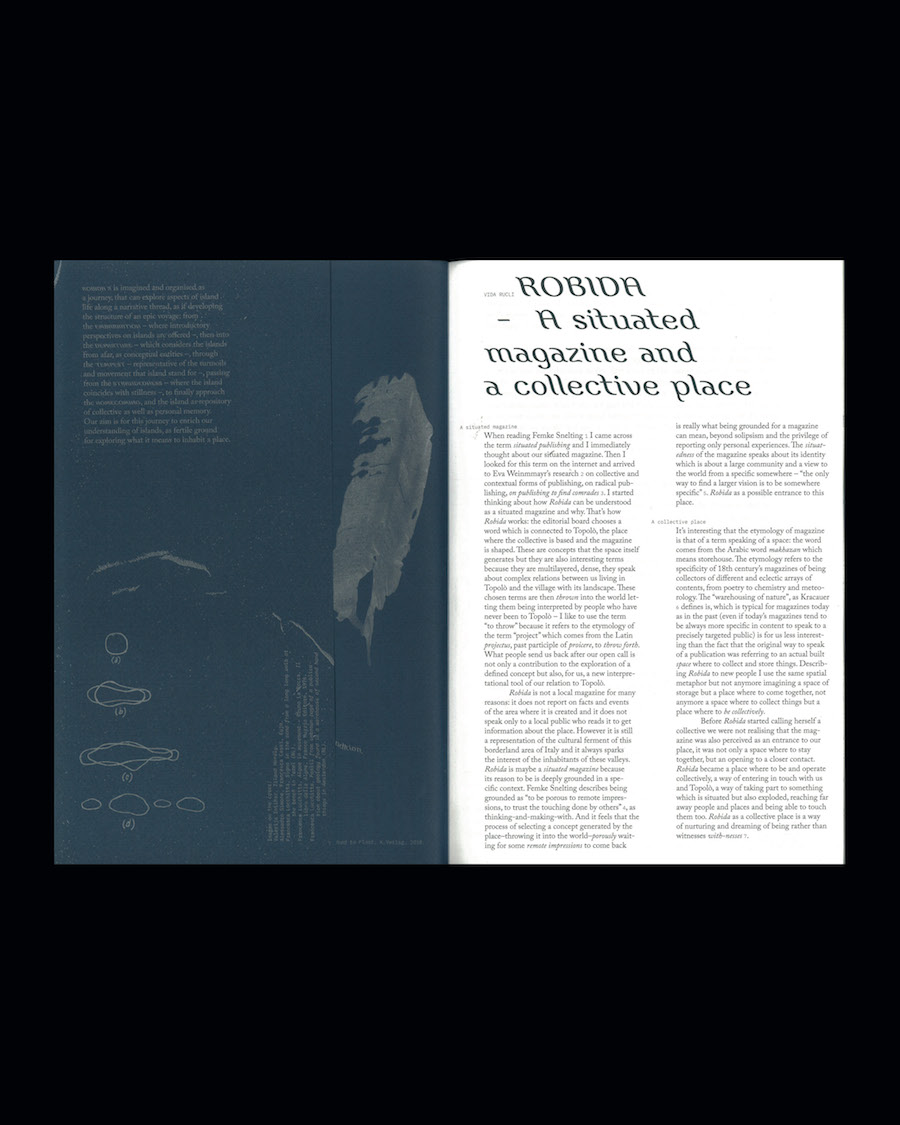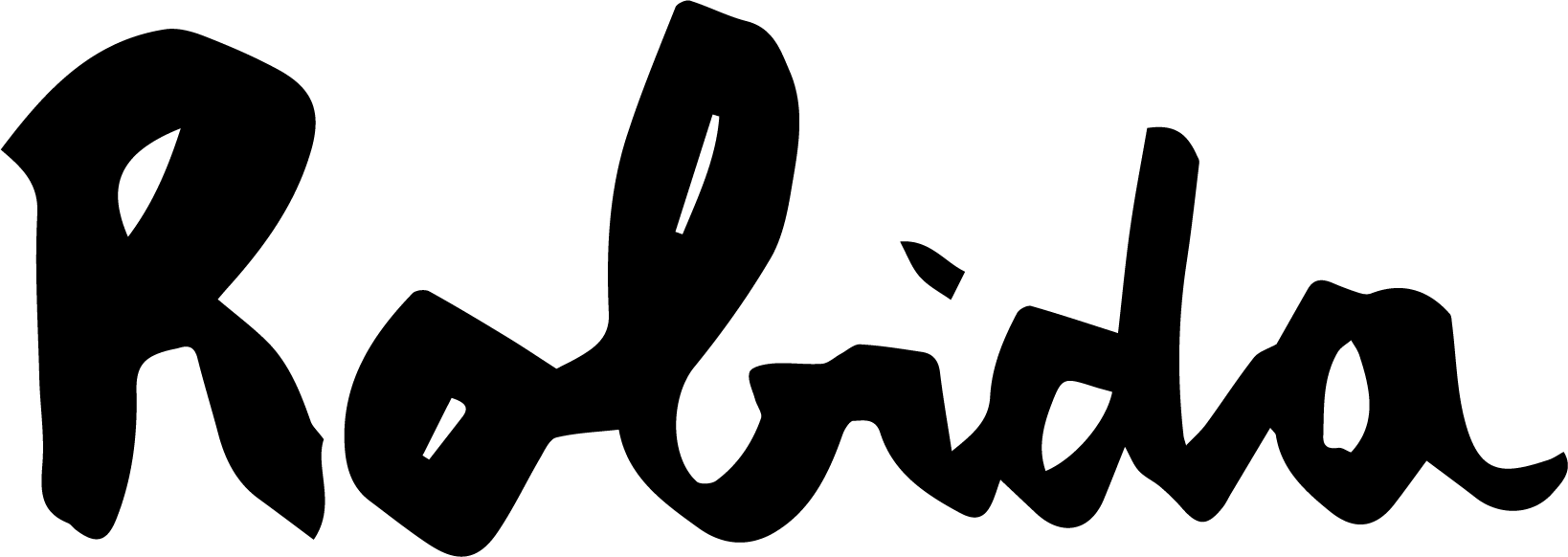Robida – a situated magazine and a collective space
– an introduction to Robida 8
A situated magazine
When reading Femke Snelting (1) I came across the term situated publishing and I immediately thought about our situated magazine. Then I looked for this term on the internet and arrived to Eva Weinmmayr’s research on collective and contextual forms of publishing, on radical publishing, on publishing to find comrades (2) . I started thinking about how Robida can be understood as a situated magazine and why. That’s how Robida works: the editorial board chooses a word which is connected to Topolò, the place where the collective is based and the magazine is shaped. These are concepts that the space itself generates but they are also interesting terms because they are multilayered, dense, they speak about complex relations between us living in Topolò and the village with its landscape. These chosen terms are then thrown into the world letting them being interpreted by people who have never been to Topolò – I like to use the term “to throw” because it refers to the etymology of the term “project” which comes from the Latin projectus, past participle of proicere, to throw forth. What people send us back after our open call is not only a contribution to the exploration of a defined concept but also for us a new interpretational tool of our relation to Topolò.
Robida is not a local magazine for many reasons: it does not report on facts and events of the area where it is created and it does not speak only to a local public who reads it to get information about the place. However it is still a representation of the cultural ferment of this borderland area of Italy and it always sparks the interest of the inhabitants of these valleys. Robida is maybe a situated magazine because its reason to be is deeply grounded in a specific context. Femke Snelting describes being grounded as “to be porous to remote impressions, to trust the touching done by others” (3) , as thinking-and-making-with. And it feels that the process of selecting a concept generated by the place–throwing it into the world–porously waiting for some remote impressions to come back is really what being grounded for a magazine can mean, beyond solipsism and the privilege of reporting only personal experiences. The situatedness of the magazine speaks about its identity which is about a large community and a view to the world from a specific somewhere – “the only way to find a larger vision is to be somewhere specific”. (4) Robida as a possible entrance to this place.
A collective place
It’s interesting that the etymology of magazine is that of a term spEaking of a space: the word comes from the Arabic word makhazan which means storehouse. The etymology refers to the specificity of eighteenth century’s magazines of being collectors of different and eclectic arrays of contents, from poetry to chemistry and meteorology. The “warehousing of nature”, as Kracauer (5) defines is, which is typical for magazines today as in the past (even if today’s magazines tend to be always more specific in content to speak to a precisely targeted public) is for us less interesting than the fact that the original way to speak of a publication was referring to an actual built space where to collect and store things. Describing Robida to new people I use the same spatial metaphor but not anymore imagining a space of storage but a place where to come together, not anymore a space where to collect things but a place where to be collectively.
Before Robida started calling herself a collective we were not realising that the magazine was also perceived as an entrance to our place, it was not only a space where to stay together, but an opening to a closer contact. Robida became a place where to be and operate collectively, a way of entering in touch with us and Topolò, a way of taking part to something which is situated but also exploded, reaching far away people and places and being able to touch them too. Robida as a collective place is a way of nurturing and dreaming of being rather than witnesses with-nesses.

To be continued and changed and re-worked
(1) Snelting, F. (2022). Undisciplined. In J. Wesseling and F. Cramer (eds.), Making Matters (pp. 301-303). Amsterdam, The Netherlands: Valiz.
(2) This is the title of an essay by Weinmayr. See: Weinmayr, E. (2014). OnPublishing to Find Comrades. In Oliver Kimpel (Ed.), The Visual Event, an education in appearances. Leipzig, Germany: Spector Books.
(3) Snelting, F. (2022). Grounded. In J. Wesseling and F. Cramer (eds.), Making Matters (pp. 243-246). Amsterdam, The Netherlands: Valiz.
(4) Haraway, D. (1988). Situated Knowledges. The Science Question in Feminism and the Privilege of Partial Perspective. Feminist Studies, Vol. 14, No. 3, 575-599.
(5) Kracauer, S. (1927/1995). Photography. In Levin, T. Y. (Eds), The Mass Ornament: Weimar Essays. Cambridge, Massachusetts; Harvard University Press.
(6) See the definition of with-ness in our Glossary of the Margins – you can find it on the right side of this page, where you see "ABC"
